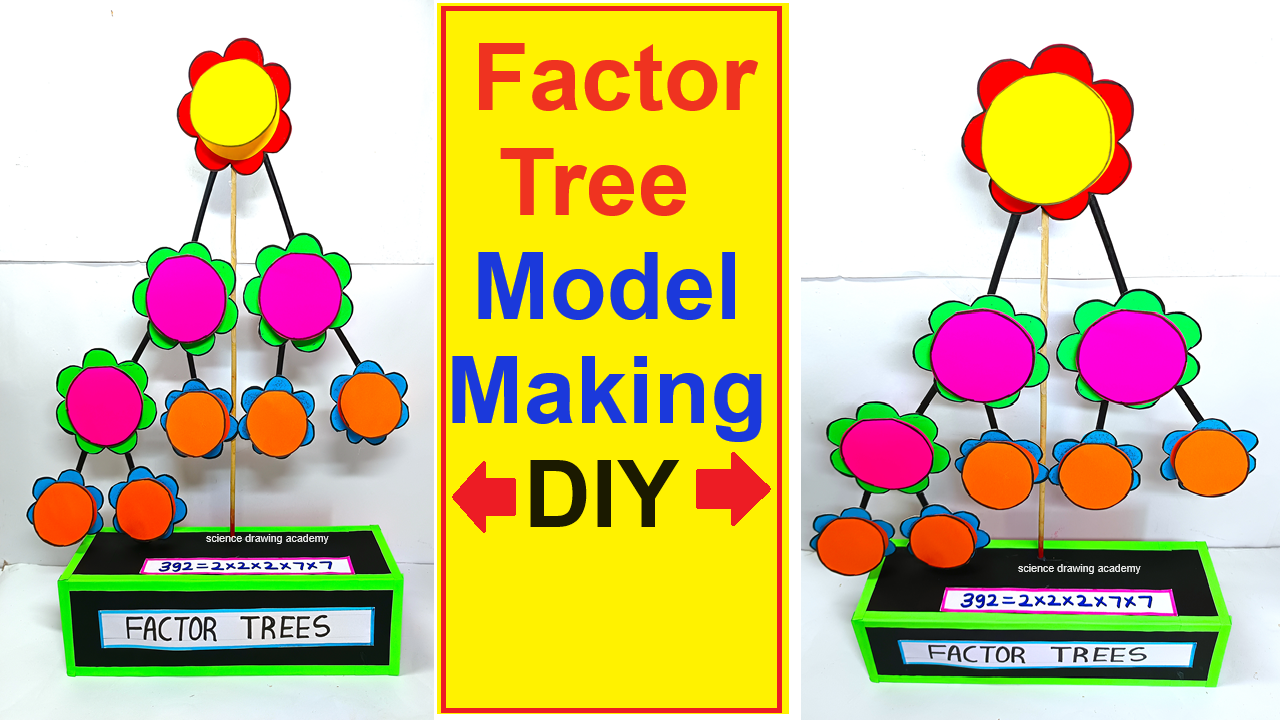Factor Tree Working Model Using Cardboard and Color Paper
A factor tree is a visual tool used in mathematics to break down a number into its prime factors. Creating a factor tree model using cardboard and color paper helps to understand the process of prime factorization in a clear and interactive way.

This project will demonstrate how to decompose numbers into their prime factors and is useful for visualizing how numbers are built from their prime components.
Introduction
The concept of prime factorization is fundamental in mathematics, especially in understanding how numbers can be expressed as products of their prime factors. A factor tree model helps illustrate this process by visually breaking down a composite number into its prime factors. By using a factor tree, one can see the step-by-step decomposition of numbers, which is essential for solving problems related to factors, multiples, and number theory.
Materials Needed:
- Cardboard (for the base and tree structure)
- Color Paper (for the numbers and branches)
- Markers, Pens, or Colored Pencils (for writing and labeling)
- Glue or Tape (for assembly)
- Scissors or Cutter (for cutting cardboard and color paper)
- Ruler (for precise measurements)
- Optional: Small Props or Stickers (for decoration)
Step-by-Step Video Instructions:
1. Prepare the Base:
- Cut a large piece of cardboard to act as the base for the factor tree. This will support the entire structure and provide a stable platform.
- Optionally, cover the base with color paper for a neat appearance.
2. Create the Factor Tree Structure:
- Cut out a large triangle or a central node from cardboard to represent the starting number of the factor tree.
- From this central node, cut out and attach branches that will split into smaller numbers as you decompose the starting number into its factors.
3. Design the Central Node:
- Write the number you wish to factorize on the central node. For example, start with 60 if you want to decompose this number.
- Decorate the central node with color paper to make it stand out.
4. Create Branches for Prime Factorization:
- From the central node, draw lines or cut out branches leading to the factors of the number.
- For each composite number, draw additional branches to break it down further until only prime numbers are left.
- Use different colors for the branches to differentiate between different levels of factorization.
5. Add Prime Factors:
- Write the prime factors on smaller pieces of color paper and attach them to the end of each branch.
- For instance, if you’re factoring 60, your factor tree will include branches leading to 2 and 30, then further branches from 30 to 2 and 15, and so on until you reach all prime factors (2, 2, 3, and 5).
6. Label Each Step:
- Label each step of the factorization clearly to show how the number is broken down at each stage.
- Include arrows or lines to show the path from the composite number to its prime factors.
7. Optional: Add Decorations:
- Use small props, stickers, or additional decorations to make the model visually appealing and engaging.
- For instance, you might add small icons or images related to multiplication and division to reinforce the mathematical concepts.
8. Assemble the Factor Tree:
- Attach all the parts together on the base. Ensure that the branches are securely fixed and the entire structure is stable.
- Double-check the accuracy of the factorization and the clarity of the labels.
Conclusion:
This factor tree model visually represents the process of prime factorization, making it easier to understand how composite numbers can be broken down into their prime factors.
By using cardboard and color paper, the model becomes an interactive and educational tool that illustrates mathematical concepts in a clear and engaging manner.
This project helps students grasp the fundamentals of factors and primes, enhancing their ability to solve problems related to number theory and arithmetic.

